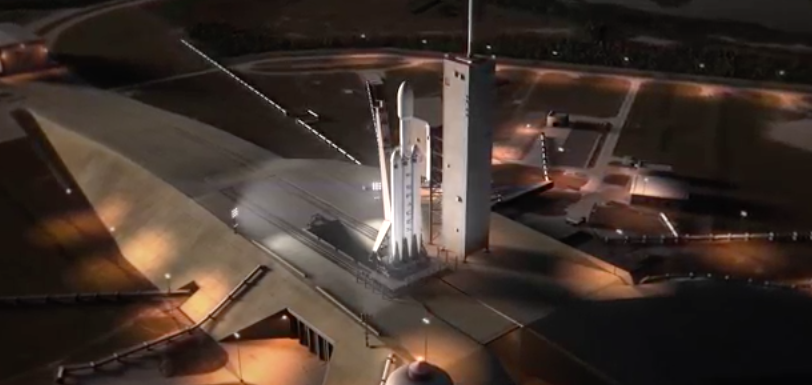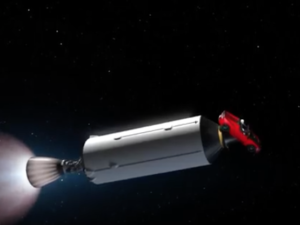
Tuesday afternoon is when SpaceX Founder Elon Musk finally gets to say to the world without any dispute:
“Mine’s bigger,” he could say.
If weather and technical matters allow, at 1:30 p.m. Tuesday SpaceX will launch its Falcon Heavy rocket from Complex 39A for its maiden flight, a blastoff sending the world’s biggest, most-powerful rocket spaceward from Kennedy Space Center.
And this will be more than just a test launch; it’s got a fun side for Musk. He is planning to use the launch to send one of his other beloved creations, a Tesla Roadster, deep into space, ultimately into orbit around Mars.
“Everything looks good that we are gong to launch tomorrow,” Musk said.
Yet he also cautioned that things could go wrong. SpaceX has had two Falcon 9 rockets blow up during missions. He said he’s tempering his hopes for step-by-step successes, beginning with the rocket clearing the pad, and ultimately through the rocket’s travels through the Van Allen belt, a zone of charged particles orbiting the Earth.
“It will be a really huge downer if it blows up,” Musk offered. “But if something goes wrong…we hope to learn as much as possible. This is a test mission. We don’t want to set expectations of perfection, by any means.”
The 229-foot-tall Falcon Heavy rocket, with three Falcon 9 rockets together as a first stage, plus a second stage and a has the power to lift 140,000 pounds of merchandise, twice the payload of NASA’s space shuttle rockets, and the most of any rocket since NASA’s Saturn V was retired in 1973. The current most powerful rocket currently in commercial use is the United Launch Alliance Delta IV Heavy, also featuring about half the payload capability of the Falcon Heavy.
Huge crowds of onlookers are expected along the Space Coast, perhaps as large as any seen since the space shuttle program ended in 2011 with the final launch of Space Shuttle Atlantis. With clear weather the launch may be visible throughout much of Florida.
There is a three-hour launch window starting at 1:30 p.m. The back-up launch date is Wednesday. The Air Force 45th Space Wing Weather Squadron is projecting an 80 percent chance of weather good enough for the launch on Tuesday, and 70 percent on Wednesday. The main concerns are thick clouds and lift-off winds.
“I feel quite giddy and happy, actually,” he said. “It’s going to be exciting one way or another. It’s either going to be an exciting success or an exciting failure.”
 The blazing trio of Falcon 9 boosters will lift a payload faring into lower-Earth orbit. When those three boosters fall away, a second stage would be set for about a six-hour burn, propelling the payload, the car, into deep space. From there, the Tesla Roadster will head toward Mars, where, if it makes it, it will orbit there 270 million miles from Earth, for several hundred million years. There are three cameras mounted on the Roadster that will send back what Musk predicted will be “epic views.”
The blazing trio of Falcon 9 boosters will lift a payload faring into lower-Earth orbit. When those three boosters fall away, a second stage would be set for about a six-hour burn, propelling the payload, the car, into deep space. From there, the Tesla Roadster will head toward Mars, where, if it makes it, it will orbit there 270 million miles from Earth, for several hundred million years. There are three cameras mounted on the Roadster that will send back what Musk predicted will be “epic views.”
There are some concerns for getting the car that far, particularly as it travels through the high-radiation environment of the Van Allen belt, Musk said.
“I’m not worried about the car… It’s the least of my concerns, I hope,” Musk said.
SpaceX intends to bring all three boosters back to Earth for safe landings, refurbishment, and re-use for future missions. The two lateral boosters, which will leave first, are set for simultaneous touchdowns at SpaceX’s landing pad at Cape Canaveral Air Force Station. The central booster would return to the company’s seagoing landing pad barge Christened as “Of Course I Still Love You.”
This test will largely be shaking out design questions, Musk said. Other questions would be answered over time, through questions of consistency. He expects more test launches this year, and he also hopes to begin commercial launches of the Falcon Heavy this year, if the test launches go well.
“We could be ready to do another heavy flight pretty soon, perhaps within the next three to six months,” Musk said. “We can produce Falcon Heavies at a pretty rapid rate, and whatever the demand is, we can meet it.”
This is the opening of the next era of big rockets, the first of a new generation capable of carrying large payloads into orbit and beyond.
The Falcon Heavy is the first, and for a good while it will be the largest of the new generation of large rockets. And Musk contends he can launch it for about $90 million a launch, far less than even smaller rockets cost now, because of the reusability of the boosters. He’s counting on that to intimidate competition that is developing rivals, but slowly so far.
“If we are successful with this, it will be game over for all other heavy rockets,” Musk predicted Monday.
United Launch Alliance is developing its next big rocket, tentatively called the Vulcan ACES, which would exceed the Delta IV Heavy. Blue Origin is developing its next big rocket, the New Glenn, capable of carrying about two-thirds the payload of a Falcon Heavy. NASA and its commercial partners Boeing, United Launch Alliance, Orbital ATK, Aerojet Rocketdyne, are developing the next big thing, still dubbed the “Space Launch System,” a rocket that will be twice as powerful as the Falcon Heavy when it debuts sometime in the early 2020s.
Musk said the Falcon Heavy could be made even bigger, with two more boosters, for a total of five in the first stage, what he called a “Falcon Super Heavy,” which he said would give it a payload capability very close to that of the Saturn V.
In typical Musk showmanship fashion, the company has produced an animation video showing the rocket’s launch, the boosters’ return, and the car’s trip toward Mars.
SpaceX has four missions for the Falcon Heavy listed on its manifest of future launches, including a test launch for the U.S. Air Force scheduled for as early as April 30, and which is cited as the second launch of the big rocket. SpaceX also lists contracts for three commercial satellites to fly atop the Falcon Heavy, one for California-based VIASAT, one for British INMARSAT, and one for Saudi Arabia’s Arabsat. All would be launched from Kennedy Space Center’s Launch Complex 39A. No dates have been set for them.
Yet this demonstration is as much about setting a milestone for one of Musk’s other dream ventures – going to Mars – as it is for assuring entry into the market of commercially trucking very large, very heavy payloads into space.
SpaceX lists the rocket’s capabilities for lower-Earth orbit, geosynchronous transfer orbit, Mars and Pluto.
And for more than two years now Musk has been at least in his statements on a mission independent of NASA’s 2o-year, SLS-vesseled, “Journey to Mars” program to get human beings to the red planet. The company’s description of Falcon Heavy declares, “Falcon Heavy was designed from the outset to carry humans into space and restores the possibility of flying missions with crew to the Moon or Mars.”



